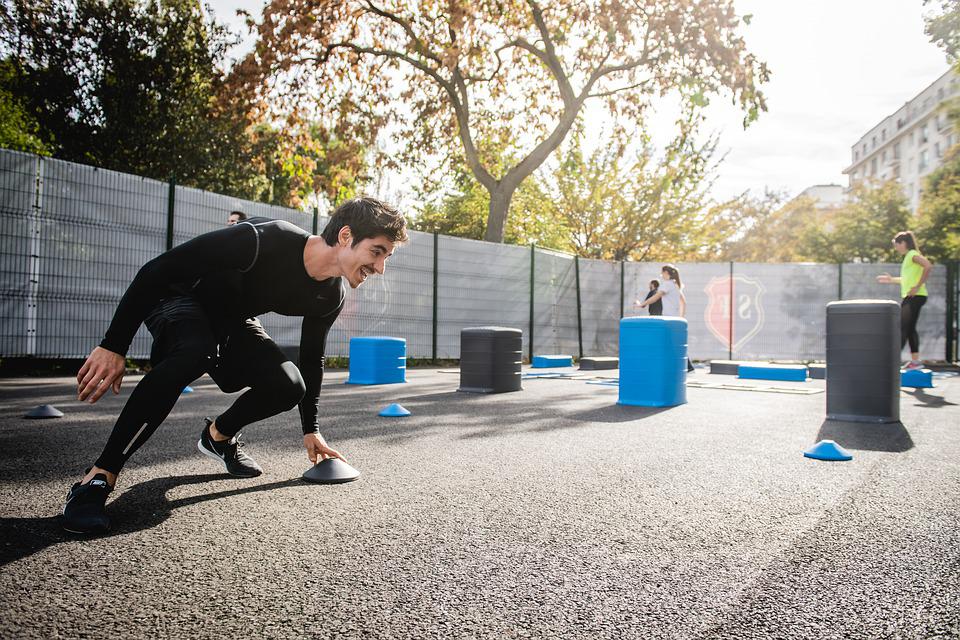
Crossfit and cross-training both advocate a multidimensional mindset towards fitness, but there are some differences between the two. That being said, if you’re looking to do some straight hypertrophy sets, it’s best to follow a defined strategy to achieve maximum muscular potential.
Crossfit focuses on functional movements that activities you would do in everyday life. Cross-training aims to combine specific training modes to improve the primary sport.
This article provides an overview of Crossfit vs. cross-training to help those who need clarification in their decision-making.
What is Cross-Training
Cross-training is any form of exercise that is done outside of an athlete’s main sport. For example, a runner who strength trains on non-running days or a powerlifter who does sprint intervals on the bike to improve their conditioning would be considered to be cross-training.
Cross-training is a term used to describe any activity that is different than the drills and routines an athlete would practice for their sport. It can be anything and does not have to have a specific structure.
How does cross-training prevent muscular imbalances? Cross-training prevents muscular imbalances by providing athletes with an opportunity to work on muscles that they don’t typically use and also to do activities that they might not have time to do during their competitive season. This allows them to maintain a well-rounded level of fitness and avoid any imbalances that could occur from overuse of certain muscles.
What is CrossFit
CrossFit training includes various fitness domains such as endurance, stamina, power, strength, flexibility, balance, coordination, speed, accuracy, and coordination.
CrossFit is notable for the variety of its exercises. It doesn’t focus on one area of fitness to the exclusion of others, but instead teaches that cardio, strength, bodyweight skills, and the ability to move quickly and efficiently are all equally important.
CrossFit is a fitness program that often uses movements that are similar to those done in everyday activities, such as picking up heavy objects or carrying bags of groceries.
CrossFitters you see on TV have their own individualized programming or follow programming created specifically for competitors, whereas CrossFit classes for the general population all follow a similar structure.
A CrossFit class typically starts with a warm up, followed by 20-30 minutes of strength or skill work. The workout of the day (WOD) is next, and the class ends with a cooldown. CrossFit gyms either have their own workout plans for each day or follow programming from other CrossFit professionals.
Cross-Training vs CrossFit: 4 Differences
- Terminology and legality
Cross training is a term that can be used to describe any type of workout that uses a variety of exercises to improve overall fitness. CrossFit is a specific type of cross-training that is based on a specific set of exercises and is often done in a group setting. While CrossFit is a legal and trademarked term, cross-training is not.
Cross-training is a term for exercises that are not related to a person’s chosen sport or activity. For example, a soccer player may consider endurance sessions on the bike to be cross-training. These exercises, done outside of normal soccer training, can help make the player a better athlete by improving their endurance.
Although Crossfit includes different types of training, it cannot be considered cross training unless the workouts are done outside of the usual sports training.
- Exercise selection
CrossFit is a workout that tests your strength, endurance, and ability to train at a high intensity. There are also a lot of bodyweight movements involved in CrossFit.
CrossFit has different workouts of the day at different gyms. You can either take a class at a CrossFit gym or follow someone else’s programming to train at home. The workouts are set out for you to do every day.
CrossFit also has themed workouts, like “hero workouts,” to remember military personnel who have died while working.
Cross-training can be anything you want it to be, depending on what part of your game you’re trying to improve.
- Social components
You are more likely to work out by yourself when you cross-train. You may be in the gym at the same time as your teammates or friends, but it is more likely that you are all focusing on your own workouts.
The main appeal of CrossFit is the strong sense of community thatCrossFit boxes create. CrossFit boxes have class times nearly every day of the week, which encourages members to interact with each other on a regular basis. In addition, many CrossFit boxes host in-house competitions, holiday parties, and birthday celebrations, which further promote a sense of community among members.
Many people who do CrossFit at home have access to coaches and others who follow the same programming through social media groups or chat features on mobile apps.
- Workout duration and intensity
Cross-training can be just as intense as CrossFit, but CrossFit is a more intense form of exercise. CrossFit often involves shorter workouts that require you to move as quickly as possible to finish a workout or complete as many rounds as possible within a given time frame.
Many CrossFit workouts only last 12-15 minutes. Some people might find this easy, but you have to push yourself hard the entire time.
Instead of short, intense workouts, when you do cardio for cross-training you will do it for at least 30 minutes. This pace is more sustainable and won’t make you breathe heavily after a short amount of time.
Cross-Training During Rest Days
Recovery is essential for any training program if you want to see improvements. The human body doesn’t restore or rebuild itself during the exercise period, it does that during the recovery period. If you exercise without proper rest, you’ll eventually overtrain.
Active recovery does not mean that you have to be idle on your days off. In fact, active recovery is a type of recovery that allows you to restore physical features and maintain your physical abilities at their peak. This can reduce your recovery time and prepare you for the next workout day.
If weight lifting is your main exercise, you can do swimming or water aerobics during your recovery time. This is an example of cross-training, where you do another activity as part of your plan for active recovery. Cross-training is different from Crossfit, which is one exercise routine.
Cross-training vs. Crossfit for Fitness
For individuals who don’t use Crossfit as their primary workout, cross-training can bring about similar benefits. Engaging in different physical activities improves overall fitness, whether it’s in one package like Crossfit or a combination of separate activities.
Training muscles from different angles helps to improve functionality and health benefits. Blending cardio, weights, and stretches also helps improve functionality and health benefits.
However, Crossfit is designed to improve fitness. Therefore, Crossfit is the best for all-around fitness.
Cross-Training vs. Crossfit to Improve Sports Performance
Although your primary sport may challenge your physical abilities, it may overlook the importance of other contributing factors. With cross-training, you can put special emphasis on weaknesses that will eventually contribute to the performance of your primary sport.
While Crossfit does not have a specified focus, it seeks to improve all aspects of fitness evenly. Cross-training, on the other hand, can be designed to target certain features that would be most beneficial to the athlete’s primary sport. Therefore, cross-training is a better option for athletes who have a primary sport that they focus on.
Lose Weight by Cross-Training
The American Council on Exercise says that cross-training can help you lose weight by increasing your calorie-burning rate. When you use different muscle groups during your workout, you use more energy and can work out for a longer period of time.
Avoid Fitness Plateau with Cross-Training
Doing different exercises prevents your body from getting used to any one particular routine, so you keep making progress instead of plateauing. This also keeps your muscles guessing what they’ll have to do next, so they stay engaged and ready for action.
Benefits of Cross-Training
- It can help prevent injuries
If you’re training for a particular sport, you might do the same activities and training drills repeatedly. That could lead to overuse injuries because the same muscles are being used in the same way over and over.
Training in other exercises besides your usual routine helps build strength in muscles you don’t use often. This also strengthens the ligaments and tendons around your joints and muscles, making them less likely to get injured.
Cross-training allows you to remain active even if you have an injury by working out other parts of your body.
- It helps make you a better athlete
Doing different types of exercise can help improve your balance, coordination, and agility, which are all important for playing most sports.
Cross-training gives you the chance to work out different muscles and improve your physical abilities. This can help reduce your risk of injuries and create a stronger, more balanced body.
Interval training can help improve your athletic performance by promoting blood flow to sore muscles and preventing stiffness. This will help your body be prepared for your next competition, game, or practice.
- You have a lot of flexibility
You can choose which activities to focus on while cross-training, depending on what you want to improve. Some activities may help you improve skills necessary for your primary sport, like a vertical jump in basketball.
For example, you can improve your endurance by biking, running, or swimming for your cross-training workouts. You can improve your strength by doing a variety of upper and lower body movements.
Around your sports training, you also have room to schedule your cross-training workouts. A couple of days per week, you can still prioritize training for your sport while focusing on cross-training.
- It can keep you motivated
If you’re struggling to stay motivated in your current sport, cross-training could be a good way to switch things up and keep your body and mind stimulated.
Cross-training is also beneficial when you’re not training for a specific sport so you can maintain your fitness while giving your body a break.
Cross-training provides you with the chance to participate in other sports that you like.
Benefits of CrossFit
- Anyone can do it
Many people think CrossFit is too hard for them, and some moves like bar muscle-ups definitely are when you start.
It is possible to make any CrossFit workout easier by adjusting the weight, movements, reps, or rounds.
And you shouldn’t worry about coming in last during a workout. I used to go to a CrossFit gym and I often came in last, but I kept going because I loved it.
If you’re not planning to compete at a high level, there’s no need to worry about being the best.
- There’s a lot of variety
If you find yourself bored easily when working out or have difficulty deciding what to focus on, CrossFit is an ideal training regimen for you.
I was first attracted to CrossFit a few years ago because it seemed like the perfect way to get all the exercise I wanted in one workout. I enjoy lifting weights, running, and doing HIIT workouts, and didn’t want to have to choose one or the other.
There is a wide range of CrossFit workouts, so you can easily find one to suit your schedule. If you go to a CrossFit gym, you’ll be limited to the class times. But if you workout at home by yourself, you can do an effective workout in as little as 10 minutes, if that’s all the time you have that day.
- CrossFit has a strong community
Many critics say CrossFit is cult-like, and while I see their point to some degree, I also understand why people who do CrossFit get so enthusiastic about it. When you find a CrossFit gym with people whose personalities you get along with and who support your fitness goals, it’s easy to see why it’s such a popular workout option.
I like CrossFit because it allows me to meet people from other parts of the world. CrossFit boxes typically welcome non-members who are traveling and just want to stop in for a workout. This provides an opportunity to interact with people from other cultures who are also interested in fitness.
- You get to learn new skills
CrossFit moves are often things you don’t see in everyday gyms, like handstand push-ups and rope climbs. If you want to learn the two Olympic weightlifting moves, the snatch and the clean and jerk, you can also do that. And if your CrossFit location has things like tires and yokes (like what Strongman/Strongwoman competitors use), you can train with those, too.
CrossFit is perfect for people who are looking for a training program that is outside of their comfort zone. The program encourages people to try new things.














